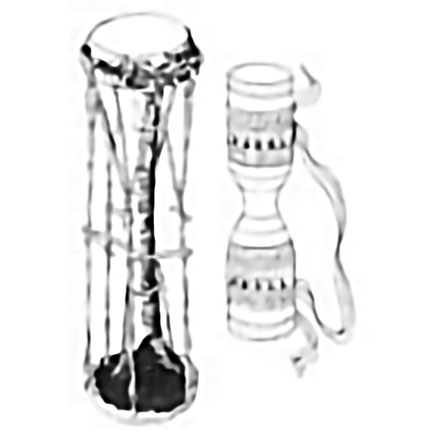wangdou overview
 Wangdu (pinyin: Wāng dōu), also known as yellow mud drum, long drum and horizontal drum. The Yao ethnic group is a mixed percussion instrument. It is popular in Liannan Yao Autonomous County of Guangdong Province and other places. Originating from the ancient slender waist drum, it has been widely circulated among the people during the Southern Song Dynasty. Li Laizhang's "Lianyang Bapai Fengtu Ji" in the Qing Dynasty records: "(Pai Yao) beats the gongs and Laos long drums on the Lantern Festival, jumping and making gestures, the shape of the long drum is large, medium and small, coated with yellow mud, hanging on the neck with rope, or Yun Yi ancient."
Wangdu (pinyin: Wāng dōu), also known as yellow mud drum, long drum and horizontal drum. The Yao ethnic group is a mixed percussion instrument. It is popular in Liannan Yao Autonomous County of Guangdong Province and other places. Originating from the ancient slender waist drum, it has been widely circulated among the people during the Southern Song Dynasty. Li Laizhang's "Lianyang Bapai Fengtu Ji" in the Qing Dynasty records: "(Pai Yao) beats the gongs and Laos long drums on the Lantern Festival, jumping and making gestures, the shape of the long drum is large, medium and small, coated with yellow mud, hanging on the neck with rope, or Yun Yi ancient."The drum body is made of a whole section of paulownia wood and fir wood, and the two ends are covered with goat skin, yellow skin or dog skin. For double pulling, put seven small bamboo tubes into two adjacent ropes respectively, and move the small bamboo tubes to adjust the tension of the drum skin. Wangdu is in the shape of a long cylinder, and its shape is somewhat similar to the Gonghuang mud drum of the Yao ethnic group in Jinxiu'ao. The total length is 90 cm, the middle part of the drum body is slightly thinner, and the two ends are slightly thicker. One end is trumpet-shaped with a diameter of 22 cm, and the other end is bowl-shaped with a diameter of 19 cm. The outer surface of the drum body is painted with red lacquer and painted with golden ethnic patterns.
Before playing, first apply wet yellow mud on the drum surface, so that the distance between the two ends of the drum sound is four or five degrees, and then a loud and rich sound can be produced. When playing, hang the drum belt diagonally in front of the chest, with one end of the trumpet-shaped drum facing the upper left, hold a bamboo piece in the left hand to play the drum surface, and the right hand slaps the drum surface on the right. ". Often two people play against each other or multiple people perform collectively, and it is mostly used in festive festivals, folk activities such as "returning the king's wish" and celebrating the harvest. It is not only the main accompaniment instrument of "Wangdu Drum", but also a dance prop.
- Pinyin:Wāng dōu
- type:percussion
- alias:Yellow mud drum, long drum, horizontal drum
overview of other similar instruments
- sanyanxiao overview
- Daguangxian overview
- Leiqin overview
- hahao overview
- yandundagu overview
- Han Xiaozheng overview
- Fang Xiang overview
- guanzi overview
- zhuqin (Dao Qin) overview
- zhuiqin overview
- bangzi overview
- three-stringed piano overview
- Gehu overview
- xiao overview
- xiaokonghou overview
- Konghou overview
- Sheng overview
- suona overview
- hulusi overview
- gushao overview
 渝公网安备 50010702504639号
渝公网安备 50010702504639号